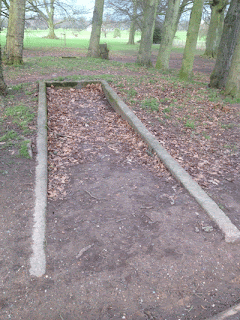Blitz-Bits
Wednesday, 2 October 2013
The Banner Lane Barrage Balloon Anchors
Tuesday, 4 June 2013
The air raid shelter under Jubilee Crescent
View Jubilee Crescent Air Raid Shelter in a larger map
Thursday, 25 April 2013
Reminders of Coventry's Pre-war Tram network
I had known that Coventry had a tram network before the war, with trams passing through Broadgate and other areas of the city but I didn't appreciate that there are still signs of it remaining. I've read a few books that indicate that after the November blitz, where the tramlines were badly damaged, the system had been abandoned. Recently I realised that just down the road from where I work on the Albany road by the junction of Broomfield road (by the railway bridge) a former tramway traction pole still exists. I took a walk down to take a look at it on a lunch break and lo and behold there it is. Below is a picture of the pole in its current condition but its quite nice to compare against the pre-war image to see it in the same place with a tram rumbling nearby. It does make you wonder what you take for granted as you walk past it on the street.
View Pre-War Tram traction poles in Coventry in a larger map
Tuesday, 26 March 2013
Barrage Balloon Anchors
Thursday, 21 March 2013
The War Memorial Park shelter from above
From above you can see the line of trees (inside the white box) that shoots out from the path. The shelter is located under these trees which are pretty dense here in a picture from 1997. Compare the same area from an aerial photograph from 1945 below.
Friday, 15 February 2013
The Air Raid Shelter in The War Memorial Park
If you take a walk along the path from the main War Memorial Park Car Park and head towards 'Coat of Arms Bridge' then you will eventually come across this interesting concrete shape built in to the ground next to a small tree covered area.
This is the entrance to a Second World War air raid shelter. In the distance you can see the square concrete secondary hole located at presumably the other end of the shelter underground. This shelter has been completely filled in and had become overgrown, hidden from view, until the 'Friends of the War Memorial Park' cleared the entrance recently. Presumably if dug out this would reveal steps leading down between the concrete walls in to the shelter. As there was barrage balloons and anti aircraft guns located in the park it has been mentioned that this shelter was used for both the storing of equipment and the protection of the people operating these devices.
View Coventry War Memorial Park Air Raid Shelter in a larger map
Friday, 25 January 2013
Welcome to my blitz bits blog
I've always been fascinated by that period in our countrys history where most nights were spent cowering in cold and damp air raid shelters in the garden or street. I am of course referring to the blitz. As I live in Coventry i have a permanent reminder on my doorstep of this time in the shape of the ruined old cathedral. Most Coventrians know what happened to our city 70 years ago. What most don't know is that there are quite a number of telltale hints in our geography to either the damage done, the preparations taken or the monuments erected in memory of this period. Some of these I have heard of through the local media, older residents or other sources. I suspect there are many I have not discovered yet. Hopefully in this amateur blog I might be able to show a few within my city and maybe learn a few things along the way.

































